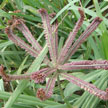Cultivation Practices
Soil
- Ragi is cultivated on a variety of soils ranging from rich loam to poor shallow upland soils.
- It prefers porous and well drained loam to light red loam and sandy loam soils of good fertility but reasonable water holding capacity.
- It can tolerate some water logging. Black soils with sufficient drainage capacity also support to cultivate Ragi crop.
- In southern India, it predominates on marginal soil conditions, provided by lateritic and red sandy loams.
- It withstands and thrives well on slightly alkaline soils too. It seems to have ability to utilize rock phosphate than other cereals do.
- The soil should be rich in organic matter. Deep vertisols and rocky soils are not suitable for this crop owing to poor drainage and low fertility.
- It can be grown in soils with pH of 4.5-7.5.
- Tank silt is applied to the soil just before the rain begins and soon after the land is ploughed thrice to incorporate weeds in the soil.
- Heavy clay soils with poor drainage is less suitable
 Top of page
Top of page
Land Preparation
The land is prepared separately for irrigated and rainfed conditions. In areas with a rainfall of 60 to 75 cm, ragi is cultivated as a rainfed crop. So the field should be deeply ploughed for moisture conservation. But in irrigated crop, plough the field immediately at the arrival of monsoon until gets fine tilth.
Preparation of Main field
i. Tillage
| Irrigated | Rainfed |
|---|---|
|
|
 |
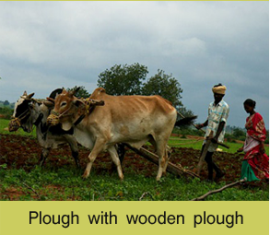 |
 Top of page
Top of page
ii Application of FYM or Compost
| Irrigated | |
|---|---|
|
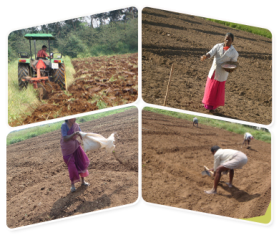 |
 Top of page
Top of page
iii. Application of fertilizers
| Irrigated | Rainfed |
|---|---|
|
|
 Top of page
Top of page
iv. Forming beds and channels
|
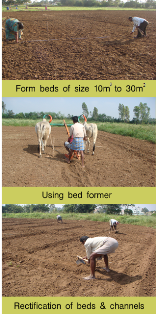 |
 Top of page
Top of page
v. Application of micronutrient mixture
- Mix 12.5 kg/ha of micronutrient mixture formulated by the Agriculture Department with enough sand to make a total quality of 50 kg/ha.
- Apply the mixture evenly on the beds.
- Do not incorporate the mixture in the soil.
 Top of page
Top of page
Sowing and Transplanting
A plant population of 4 to 5 lakhs per ha is optimum for getting higher yields and higher or lower population than the optimum will reduce the yield. There are various methods practiced for ragi cultivation.
- In rainfed ragi, ragi is grown as intercrop or mixed crop with non cereal crops.
- In irrigated ragi, ragi is grown as sole crop.
The following methods are used for irrigated and rainfed ragi.
 Top of page
Top of page
Direct Sowing
Direct sowing is the practice of sowing seeds directly in the main field, eliminating the process of seedling raising and transplanting. The seeds are sown in the prepared land before or with the onset of monsoon. The following three methods used for sowing ragi seeds.
i. Broadcasting
|
 |
 Top of page
Top of page
ii. Line Sowing
|
 |
 Top of page
Top of page
iii. Drilling in rows
|
 |
 Top of page
Top of page
Transplanting
Transplanting is the practice of raising the seedlings in nursery and transplant.
a. Transplanting the seedlings
- Irrigate the beds during transplanting and level the bed if it is not levelled
- 3 to 4 weeks seedlings should be transplanted in the field
- Transplant 2 to 3 seedlings per hill in normal planting and 4 to 6 seedlings in delayed planting.
- For early kharif and Rabi season, plant 21 – 25 days old seedlings at a spacing of 25 cm x 10 cm
- For Late Kharif season, plant 25-28 days old seedlings at a spacing of 30 x 10 cm
- Plant the seedlings at a depth of 2 to 3 cm. Deeper planting delays tillering and root regeneration, increases duration and flowering at different times
- Transplant in lines at proper spacing to maintain the correct level of panicles per metre. This also eases subsequent operations. Random planting leads to uneven growth of tillers and reduce panicles per metre.
- Prepare slurry with 5 packets (1000g) per hectare of Azospirillum inoculant in 40 litres of water and dip the root portion of the seedlings in the solution for 15 to 30 minutes and transplant.
- Dip the leafy portion of the seedlings in 0.1% carbendazim solution before planting to arrest the transfer of blast to main field.
- The beds should be irrigated on the third day after transplantation
- Replace the dead hills with new seedlings from the same nursery within one week
b. Management of aged seedlings
- When planting ragi seedlings beyond 21 days, increase the number of seedlings to 3/hill and increase N level by 25% to minimize yield loss.
- Maintenance of optimum plant population is an important prerequisite for getting higher yield under rainfed conditions. Poor germination, often, is the result of inadequate moisture after sowing in low rainfall areas. Under these conditions, the adoption of a simple technique like seed hardening will not only improve germination and subsequent plant stand but also impact early seedling vigour and tolerance to drought.
The procedure of seed hardening technique is as follows:
Step 1: Soak seeds in water for 6 hours. Use one litre of water for every kg seed for soaking.
Step 2: Drain the water and keep the seeds in wet cloth bag tightly tied for two days.
Step 3: At this stage, the seeds will show initial signs of germination.
Step 4: Remove seeds from the wet cloth bag and dry them in shade on a dry cloth for 2 days.
Step 5: Use the above hardened seeds for sowing.
 Top of page
Top of page
Cropping System
The cropping system is an important component of any farming system. It is the proportion of area under various crops at a point of time. It is designed to mimic nature and bring diversity into the farming system. Commonly practiced cropping systems are:
 Top of page
Top of page
Crop Rotation
Crops are grown in a planned sequence from season to season within a year or from year to year. Under Irrigated condition, it is grown in rotation with crops like chillies, vegetables, turmeric, tobacco, gram, mustard, barley, linseed etc. Crop rotation will minimize inorganic fertilizer application and also sustain higher yields. Ragi - Maize (2 year crop rotation) gave higher yield per unit area as compared to Ragi - Ragi crop rotation. |
 |
Some of the common crop rotations adopted in north and south India are given below.
| North India | South India |
|---|---|
| Ragi - Mustard | Ragi - Tobacco |
| Ragi - Gram | Ragi - Groundnut |
| Ragi - Barley | Ragi - Potato - Maize |
| Ragi - Linseed | Ragi - Potato - Ragi |
| Ragi - tobacco | Ragi - Sugarcane |
In Southern Karnataka, rotation of ragi is followed with crops like castor, horse gram, pigeon pea, green gram, black gram and cow pea.
| Year | Season | Crop Rotation | Advantage |
|---|---|---|---|
| I | Kharif | Castor & Horse Gram | Minimum Cost Of Cultivation Enrichment Of Soil Fertility Suitable For Drought Conditions |
| II | Kharif and Rabi | Pigeon Pea | Multiple harvest no additional cultivation cost effective utilization of land. |
| II | Kharif | Green gram, Black gram, Cowpea | Nitrogen Fixation in Soil Fodder Availability For Cattle-Double Cropping System In Dry Land Conditions. |
 Top of page
Top of page
Intercropping
Intercropping is the agricultural practice of cultivating two or more crops in the same space at the same time.Intercropping also uses the practice of sowing a fast growing crop with a slow growing crop Ragi is grown under rainfed conditions mixed or intercropped with sorghum, pearl millet and various oilseeds and pulses. The most common subsidiary crops grown ragi are field bean (Lablab purpureus), pigeon pea (Cajanus cajan), cowpea (Vigna sinensis), and Niger (Guizotia abysinnica). With groundnuts, ragi is the subsidiary crop. In hills it is grown mixed with soybean. Some of the common rotations are given below:
|
 |
Maize and millet intercropping is the best planting arrangement to produce the highest yield. The intercropping environment also minimized the occurrence of disease and lodging in millet. The combined yields of the different intercropping combinations were 5-25% higher than that of a mono crop.
Intercropping of finger millet (transplanted) + pigeon pea in the row ratio of 4:1 is better in terms of finger millet equivalent yield (66 q/ha), net returns (Rs. 20 thousand/ha) under rainfed condition.
Sometimes the ragi intercropped with mustard, because mustard flowers bloom during the early stages of the ragi crop and attracts lady bird beetles, a predator of aphids, attacking the ragi crop. In case of rain failure, mustard acts as an insurance crop.
 Top of page
Top of page
Mixed cropping
|
 |
 Top of page
Top of page
Strip Cropping
Strip crops are crops that are normally taken up by farmers or introduced as intercrops, in systematic bands of multiple rows, which alternate with the rows of the main crop, usually across the slope. This also acts as a barrier to runoff water. Some of the strip cropping are given below:
Strip cropping of Ragi and field bean/pigeon pea in 3:1 proportion resulted in enhancing the productivity per unit area. |
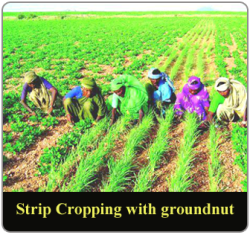 |
 Top of page
Top of page
Intercultural Practices
Intercultural operations help in keeping the soil loose and friable and also permit the retention of moisture as well as adding organic fertilizer to the soil. Weeding is a practice of removing unwanted plant in the field by using hand or implement or spraying weedicides. Weeding and hoeing helps to avoid the competition for space, nutrients, water and keep the crop healthy. However, weeding is considered as one of the important intercultural operations in this crop.
i. Intercultural practices in karnataka
Interculturing and weeding are simpler in transplanted ragi cultivation. The prevailing practice is as follows:
1. Interculturing with a hand-hoe (gudali in Karnataka) 30 days after transplanting
2. First weeding with a hand weeding implement (kalekudulu in Karnataka) 10 days after interculturing
3. Second hand weeding with the same implements five days after the first
Interculturing and weeding using animal power is rarely seen in the areas of ragi cultivation. There are four operations are practiced for ragi sown as sole crop. They are Thinning-cum-interculturing, Weeding with an implement pulled by bullocks, Hand weeding and Intertillage.
a. Thinning-cum-interculturing
a. First thinning-cum-interculturing using a tine-harrow(Kunte in Karnataka) pulled by a pair of bullocks, 15 days after sowing. At this time, the ragi has germinated and begun in the initial growth stage. As ragi is densely sown, thinning is necessary. This is generally done with a pair of harrows with four tines each, pulled by bullocks’ perpendicular to the sowing rows to make thinning effective.
b. Second thinning-cum-interculturing 4 to 5 days after the first. Same methods and implements as in first thinning-cum-interculturing. This second stage uses a harrow with four tines. The young ragi plants eliminated by thinning at this time are used for complementary planting in the ungerminated portions of the rows.
b. Weeding with implement
a. First weeding using bullocks, 10 days after second thinning. A special implement called dharle in Karnataka, which has four times and two blades, is used. The blades are attached to the ends of the first and second, third and fourth tines, and are used to eliminate inter-row weeds. The dharle does not interculture the soil; it is used only for weeding.
b. Inter row weeds are killed with hand weeding implement, kalekudulu after 10 to 12 days of first hand weeding. If weeds are abundant, they advance the date by a week. This work is carried out mainly by female agricultural labourers.
c.Hand Weeding
a. First hand weeding, with a dharle drawn by bullocks, takes place 4 to 5 days after weeding with implement.
b. Second hand weeding, a week after the above operation. The method and implement used are the same as in weeding with implement.
d.Intertillage
- Intertillage with a kunte drawn by a pair of bullocks, 10 to12 days after second hand weeding (f). A kunte with two tines is used.
- The farmers increase the distance between the tines so they work between the rows of ragi.
- The kunte is drawn parallel to the rows of ragi to stir up the soil in the inter row spaces.
- This operation is done about two months after sowing or in first half of September. At this time, they have the Southwestern monsoon rains in normal years.
- Intertillage is done just after these rains. Thereby storing water in the sub soil as soil moisture and eliminating inter-row weeds.
 Top of page
Top of page
ii.Intercultural practices in TamilNadu
Inter-cultural operations are mainly intended to control weeds and to provide aeration to the soil. Finger millet may be given hand hoeing to remove weeds, break clods and aerate the rhizosphere. It is essential to control weeds in the initial stage of plant growth and development. The intercultivation and weeding should be done with hand hoe after 25 days of sowing. Two to three hoeing would be sufficient. The intercultural operations are practiced differently for irrigated and rainfed ragi crop.
 Top of page
Top of page
a.Irrigated ragi crop
a.Thinning
As ragi is densely sown, thinning is necessary 15 days after sowing. Normally hand thinning is practiced. The young ragi plants eliminated by thinning at this time are used for complementary planting in the ungerminated portions of the rows.
b. Weed Management
- Hand weed twice on the 10th and 20th day after transplanting. The intercultivation and weeding should be done with hand hoe after 25 days of sowing. Two to three hoeing would be sufficient.
- Hoe and hand weed on the 15th day of planting in light soils and 17th day planting in heavy soils and subsequently on 30th and 32nd days, respectively.
- Allow the weeds to dry for 2 or 3 days after hand weeding before giving irrigation.
- Apply Butachlor 2.5 l/ha or Fluchloralin 2 l/ha or Pendimethalin 2.5 l/ha, using Backpack napsack/Rocker sprayer fitted with flat fan type of nozzle with 900 litre of water/ha.
- Apply the herbicides when there is sufficient moisture in the soil or irrigate immediately after application of herbicide.
- If pre-emergence herbicide is not applied, hand weeds twice on 10th and 20th day after transplanting.
 Top of page
Top of page
b.Rainfed ragi crop
- In line sown crop 2-3 inter-cultivations are necessary.
- In assured rainfall and irrigated areas spraying 2,4-D sodium salt @ 1.25kg./ha or Atrazine 2.5kg/ha as post-emergent spray around 20 to 25 days after sowing effectively controls weeds.
- Isoproturon @ 0.5 a.i. /ha as pre-emergence spray is also effective in control of weeds.
- In broadcast crop two effective hand weedings will minimize weeds as inter cultivations is not possible.
Apply post emergence herbicide- 2,4-DEE or 2,4-D Na salt at 0.5 kg/ha on 10th day after sowing depending on the moisture availability.
